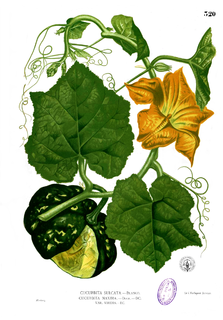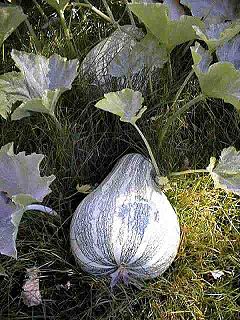
Cucurbita is a genus of herbaceous vines in the gourd family, Cucurbitaceae native to the Andes and Mesoamerica. Five species are grown worldwide for their edible fruit, variously known as squash, pumpkin, or gourd, depending on species, variety, and local parlance, and for their seeds. Other kinds of gourd, also called bottle-gourds, are native to Africa and belong to the genus Lagenaria, which is in the same family and subfamily as Cucurbita, but in a different tribe. These other gourds are used as utensils or vessels, and their young fruits are eaten much like those of Cucurbita species.

Cucurbita pepo is a cultivated plant of the genus Cucurbita. It yields varieties of winter squash and pumpkin, but the most widespread varieties belong to the subspecies Cucurbita pepo subsp. pepo, called summer squash.

Cucurbita ficifolia is a species of squash, grown for its edible seeds, fruit, and greens. It has many common names in English such as the fig-leaf gourd, Malabar gourd, black seed squash and cidra. Although it is closely related to other squashes in its genus, such as the pumpkin, it shows considerable biochemical difference from them and does not hybridize readily with them.

Cucurbita maxima, one of at least four species of cultivated squash, is one of the most diverse domesticated species. This species originated in South America from the wild Cucurbita andreana over 4000 years ago. The two species hybridize quite readily but have noticeably different calcium levels.

Cucurbita palmata is a species of flowering plant in the squash family known by the common names coyote melon and coyote gourd. It is similar to Cucurbita californica, Cucurbita cordata, Cucurbita cylindrata, and Cucurbita digitata and all these species hybridize readily. It was first identified by Sereno Watson in 1876. These species form the only restricted xerophyte species group in the genus Cucurbita. Each member of this species group is native to the Southwestern United States and Northwestern Mexico where they are relatively uncommon. Each group member is found in hot, arid regions with low rainfall. They prefer soil that is loose, gravelly, and well-drained. C. palmata is native to northeastern Baja California, southeastern California, and southwestern Arizona to a point near the Colorado River. The juvenile leaves of C. cylindrata, C. cordata, C. digitata, and C. palmata show a high degree of similarity, but their mature leaves are visibly different, as are their root structures. C. palmata and C. digitata are sympatric, with C. palmata separating the ranges of C. digitata at the juncture of Baja California, California, and Arizona. C. palmata fruits are diffuse green mottle that turns yellow at maturity, striped, and round.

Cucurbita digitata is a species of flowering plant in the squash family known by the common names fingerleaf gourd and bitter squash. It is similar to Cucurbita californica, Cucurbita cordata, Cucurbita cylindrata, and Cucurbita palmata and all these species hybridize readily. These species form the only restricted xerophyte species group in the genus Cucurbita. Each member of this species group is native to the Southwestern United States and Northwestern Mexico where they are relatively uncommon. Each group member is found in hot, arid regions with low rainfall. They prefer soil that is loose, gravelly, and well-drained. C. digitata is native to northern Baja California at higher elevations, northern Sonora, Mexico, southern Arizona, and southwestern New Mexico. The juvenile leaves of C. cylindrata, C. cordata, C. digitata, and C. palmata show a high degree of similarity, but their mature leaves are visibly different, as are their root structures. C. palmata and C. digitata are sympatric, with C. palmata separating the ranges of C. digitata at the juncture of Baja California, California, and Arizona. C. digitata fruits are clear green mottle that turns yellow at maturity, striped, and round.

Cucurbita argyrosperma, also the Japanese pie pumpkin or cushaw pumpkin, and silver-seed gourd, is a species of winter squash originally from the south of Mexico. This annual herbaceous plant is cultivated in the Americas for its nutritional value: its flowers, shoots, and fruits are all harvested, but it is cultivated most of all for its seeds, which are used for sauces. It was formerly known as Cucurbita mixta.

Cucurbita okeechobeensis, the Okeechobee gourd, is a species of gourd in the family Cucurbitaceae, native to Mexico and the United States. There are two subspecies; one is endemic to Florida, primarily in the region around Lake Okeechobee, the other to the State of Veracruz in eastern Mexico. Once abundant, it has state and federal listing as an endangered species.
Cucurbita galeottii is a plant species of the genus Cucurbita. It is native to Oaxaca, Mexico. It has not been domesticated. There is very little known about this species. Nee reports that the species is a xerophyte and that Bailey only saw the species in photographs. It is only known from specimens that "lack roots, female flowers, fruits and seeds".
Cucurbita pedatifolia is a xerophyte plant species of the genus Cucurbita. It is native to Querétaro, Mexico. It has not been domesticated. While C. pedatifolia has been cross bred, results have met with limited success. It does not cross well with other species of Cucurbita. It is a close relative of Cucurbita radicans. Geographic location and genetics make it highly likely that Cucurbita scabridifolia is a naturally occurring hybrid of Cucurbita foetidissima and C. pedatifolia. It also has some mesophyte traits may represent a transitional state between the mesophytic Cucurbita and the xerophytic Cucurbita.
Cucurbita fraterna, also known as Cucurbita pepo subsp. fraterna, is a mesophyte plant species of the genus Cucurbita. It is native to Tamaulipas and Nuevo León, Mexico. It has not been domesticated. It is the progenitor and nearest relative of the domesticated species Cucurbita pepo and wild C. pepo is still found in the same areas as C. fraterna. It was formally described by Liberty Hyde Bailey in 1943, in Gentes Herbarum.

Cucurbita texana, also known as Cucurbita pepo subsp. texana and Texas gourd, is a mesophytic plant species of the genus Cucurbita. It is native to Texas, primarily the southeastern region. It is found only in the wild. It is possibly a progenitor and close relative of the domesticated species Cucurbita pepo, though it and wild C. pepo are native to different areas. Cucurbita fraterna is also closely related. It was first collected 1835 by J. L. Berlandier in southern Texas. It was formally described as Tristemon texanus by George Heinrich Adolf Scheele in 1848 and transferred to the genus Cucurbita by Asa Gray in 1850.
Cucurbita scabridifolia is a plant species of the genus Cucurbita native to Mexico. It is a xerophyte and has not been domesticated. Very little is known about this species. Geographic location and genetics make it highly likely that C. scabridifolia is a naturally occurring hybrid of C. foetidissima and C. pedatifolia.
Cucurbita martinezii is a plant species of the genus Cucurbita native to Veracruz, Mexico. Locals use halved fruit shells as shot glasses for alcoholic drinks. It has not been domesticated. It is generally found in areas with rivers and forests.

Cucurbita andreana is a plant species of the genus Cucurbita, since 1982 in the rank of a C. maxima subspecies, C. maxima subsp. andreana, the wild relative of C. maxima subsp. maxima cultivated subspecies. It is native to Argentina and Uruguay. C. andreana fruits are smaller and not palatable, those of C. maxima are bigger and palatable.
Cucurbita moorei is a plant species of the genus Cucurbita. It is native to the vicinity of Ixmiquilpan, Mexico. It has dark green leaves with white markings and orange flowers.
Cucurbita sororia is a plant species of the genus Cucurbita, sometimes considered to be a subspecies of Cucurbita argyrosperma, C. a. subsp. sororia. It ranges from northern Mexico to Nicaragua, mostly along the Pacific coast. This species was originally considered closely related to Cucurbita texana but C. sororia was later shown to be an ancestor of Cucurbita argyrosperma, with which it hybridizes well.
Cucurbita palmeri is a plant species of the genus Cucurbita. It is native to the Pacific coast of northwestern Mexico to Nicaragua. It is closely related to Cucurbita argyrosperma and Cucurbita sororia.
Cucurbita cordata is a species of flowering plant in the squash family. It is similar to Cucurbita californica, Cucurbita cylindrata, Cucurbita digitata, and Cucurbita palmata and all these species hybridize readily. These species form the only restricted xerophyte species group in the genus Cucurbita. Each member of this species group is native to the Southwestern United States and Northwestern Mexico where they are relatively uncommon. Each group member is found in hot, arid regions with low rainfall. They prefer soil that is loose, gravelly, and well-drained. C. cordata is found only in the vicinity of Bahía de los Ángeles, Baja California. Botanists Bemis and Whitaker suggest that C. cordata and C. cylindrata may be a case of sympatric speciation. The juvenile leaves of C. cylindrata, C. cordata, C. digitata, and C. palmata show a high degree of similarity, but their mature leaves are visibly different, as are their root structures. C. cordata fruits are gray green, striped, and round.
Cucurbita cylindrata is a species of flowering plant in the squash family. It is similar to Cucurbita californica, Cucurbita cordata, Cucurbita digitata, and Cucurbita palmata and all these species hybridize readily. These species form the only restricted xerophyte species group in the genus Cucurbita. Each member of this species group is native to the Southwestern United States and Northwestern Mexico where they are relatively uncommon. Each group member is found in hot, arid regions with low rainfall. They prefer soil that is loose, gravelly, and well-drained. C. cylindrata is found only in the middle portion of Baja California, mostly in Baja California Sur. Botanists Bemis and Whitaker suggest that C. cordata and C. cylindrata may be a case of sympatric speciation. The juvenile leaves of C. cylindrata, C. cordata, C. digitata, and C. palmata show a high degree of similarity, but their mature leaves are visibly different, as are their root structures. C. cylindrata fruits are dark green, striped, and round.










